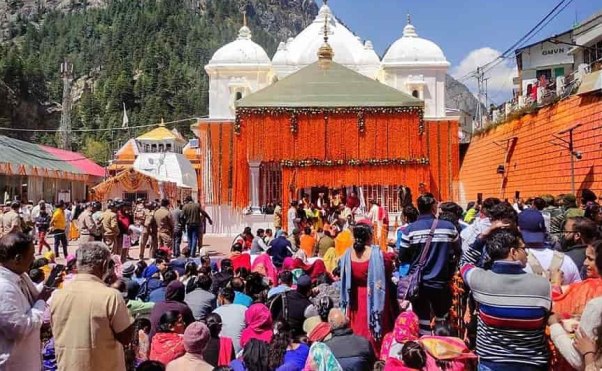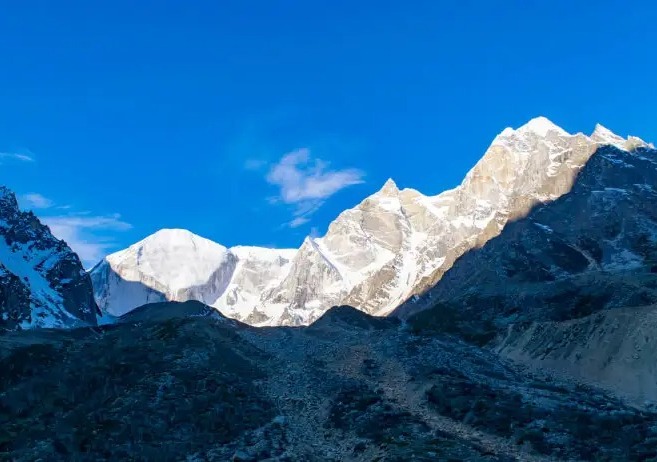Gangotri Temple Uttarkashi – Gangotri, the Devbhoomi of India, Uttarkashi district of Uttarakhand state, has a city and a Nagar Panchayat or Municipality located there. And it is also 99 km away from the main district headquarters Uttarkashi. And it is also situated on the banks of river Bhagirathi. Is a Hindu pilgrimage town. Which is not the origin place of Ganga.

the city is situated on the Greater Himalayan Range at an altitude of 3,100 meters and 10,200 feet. According to a popular Hindu legend, Goddess Ganga descended here then. When Lord Shiva has freed the mighty river from its locks.
The River Ganges
Gangotri is also one of the four sites on the Chhota Char Dham pilgrimage active circuit. Which is also the source of river Ganga. , and which also originates from the Gangotri Glacier. Once the river meets the Alaknanda river at Devprayag salt town. And so finally its name becomes Ganga.
There is a stone near that river where King Bhagirathi did penance to Shiva to bring Ganga to earth and to get rid of the sins of his ancestors and according to another legend, the Pandavas also sacrificed their lives in the epic battle of Mahabharata. The great Dev Yagya was performed here to atone for the deaths of relatives. And Hindus believe that by performing the Pit Sanskar on the banks of Bhagirathi, the souls of the ancestors are freed from the cycle of Punjanam and by taking a holy dip in its waters, one is also freed from the sins committed in the present and previous lives.
Demography

According to the 2011 census of India, only 47 families live in Gangotri. And the total population of Gangotri is 110 and out of which 97 are males and 13 are females. The literacy rate of Gangotri is 99.1% and the entire population of Gangotri identifies as Hindu.
Simple description and features of Gangotri Temple
On the Chhota Char Dham Yatra, Gangotri is one of the four Pandavas. And it is a source of river Ganga and also the home of Goddess Ganga. And people also know this river by the name of Bhagirathi. But beyond Devprayag, when it meets Alaknanda, it is also known as Ganga. And Gaumukh is situated in Gangotri Glacier itself. Which is at a distance of 10 kilometers from Gangotri, is the source of the sacred river. Amar Singh Thapa was a Nepali general who built the first Gangotri temple. And after the annual Diwali festival, the temple itself remains closed till Akshaya Tritiya. The Semwal family of priests oversee the temple rituals. And these priests come from Mukhba village.
Special importance of Gangotri Dham Uttarkashi

Gangotri is situated amidst amazing landscape and beautiful mountains. And because of its close connection with the river Ganga, it is also one of the most sacred places. And Gangotri is also one of the most revered places in India. , and every year many pilgrims visit the holy place. And Gangotri temple opens its darshan shrine gates every year on the auspicious day of Akshaya Tritiya in April and May and the temple is closed only after Diwali on Bhai Dooj. Gangotri temple also remains closed for pilgrims for six months during winter.
Gangotri Dham Uttarkashi – Legend has it that Mother Ganga, a highly revered Hindu deity, lived in the Gaumukh-covered Gangotri area, about 11 miles from the town of Gangotri. She came to earth only to wash away the sins of the king. And ancestors of Bhagirathi. Steeped in mythology, the river Ganga has been a sacred source of water to cleanse and liberate people from all their sins. Visiting Gangotri Dham on pilgrimage is not just a religious ritual but a spiritual ignorance.
Legends of Mother Ganga River – Gangotri Dham Uttarkashi
When Goddess Ganga agreed to descend on earth in answer to the prayer of Mother Bhagirathi. And so she was firm on her decision that the entire land should be submerged under water. And to save the world from this destruction, Lord Shiva also captured the river Ganga. King Bhagirathi did penance for a long time just to question Lord Mahadev.
Seeing the immense devotion of King Bhagirathi, Lord Shiva became enraged and released Mother Ganga in the form of three streams and one of which reached the earth and became known as Bhagirathi River. As soon as the water of Mother Ganga touched the remains of the ancestors of King Bhagirathi, 60 thousand sons woke up from eternal rest. And it is believed that this is the stone on which King Bhagiratha meditated. That is Bhagiratha Sheela near Gangotri temple.
According to another legend, Mother Ganga was born in Kamandalu to King Brahma and was a beautiful living woman.
Gangotri Dham – Glacier

Gangotri Glacier is situated in Uttarkashi. And Ganga is one of the main sources of mother river. And it is one of the largest glaciers in the Himalayas and the average volume is more than 27 cubic kilometers. And Gangotri Glacier is a traditional Hindu pilgrimage. Ardent Hindus consider bathing in the icy waters near the town of Gangotri a sacred ritual. And many people visit Gomukh. And some go towards Tapovan.
This video has been revealed by the scientist of Himalayan Institute (WIHG) in Dehradun. For the first time, carbon deposits have been found on the Himalayan ice cap. It is based on data collected in 2016 from two observatories with established aerosol monitors near Gangotri Ice. The presence of bulb carbon can accelerate the melting of snow. And it also has a deep impact on highly populated valleys because rapid melting of snow can also lead to river floods. Due to which it can flow on its banks. And can cause floods.
Architecture of Gangotri Maa Temple – Gangotri Dham
The magnificent architecture of Gangotri Dham attracts millions of visitors and pilgrims, or architecture and historians. And the features of the temple are as follows.
- The buildings of Gangotri Dham are built in urban style with five small towers of 20 meters length.
- There is a very beautiful sculpture on the outside of the temple. Which is rarely seen in any Hindu temple.
- This temple is also built according to Katyuri style. And which is common in or around Nepal. This style also originated in the Nepali Katyari dynasty.
- The interior of the temple follows the pattern of regular temple construction.
- Only after entering the courtyard, the pilgrims are also directed inside the assembly hall or auditorium of the temples. This assembly hall leads to the sanctum sanctorum, and the inner sanctum of the temple. Where the idol of the supreme deity has been installed.
- There is a high platform in the inner sanctum sanctorum where the idol of Mother Ganga is kept along with the idols of various gods and goddesses like Yanuma, Saraswati, Antarpurno etc.
- The sanctuary is designed in such a way that the idols of the gods and goddesses face east to reflect the first rays of the sun.
How to reach Gangotri Temple
route
From New Delhi to Haridwar and then from Rishikesh to Narendra Nagar, from there to Tehri and Dharasu Bend, then from Uttarkashi to Bhatwadi and from Gangnani to Harshit Gangotri.
route
From Delhi to Dehradun and from Mussoorie to Chamba, from Tehri to Dharasu Bend, from Uttarkashi to Bhatwari and Gangnani and then from Harshit to Gangotri.
Travel to Gangotri Dham by Air
From Jolly Grant Airport take Rishikesh Road and then Dehradun, the nearest airport to Gangotri. Hire a cab or take a bus from here.
Travel to Gangotri Dham
by train
These regular trains are also available for Haridwar and Dehradun at all times of the year. And you can also hire a cab or take a bus from here.
Best time to visit Gangotri Dham
The best time to visit Gangotri Dham would be from April, May, June, and from September to October, November.
Monsoon brings real risks of landslides, floods and other problems. Whereas heavy snowfall also occurs in winter. And the temperature is freezing.
Gangotri time in summer

In Gangotri, summer begins as early as April and ends in the month of May. And due to Gangotri having one of the best climates, the summer here is very pleasant. And even in this season the day temperature never goes above 30°c. Whereas the nights are very cold. And this season is also the best time for pilgrimage or exciting sightseeing.
Gangotri darshan during monsoon time
From late July to late September, Gangotri welcomes the monsoon. And even during the trip to Gangotri temple, many difficulties like landslides arise due to heavy rains. One should also be well equipped to handle this weather.
Gangotri darshan in winter time
The winter season in Gangotri starts only in the month of November. And lasts till March. Winters are very cold here. And at the same time heavy snowfall also occurs. The roads to the temple remain blocked. Therefore advice is also given to strangers. And they should also not plan to visit this place during winter season

